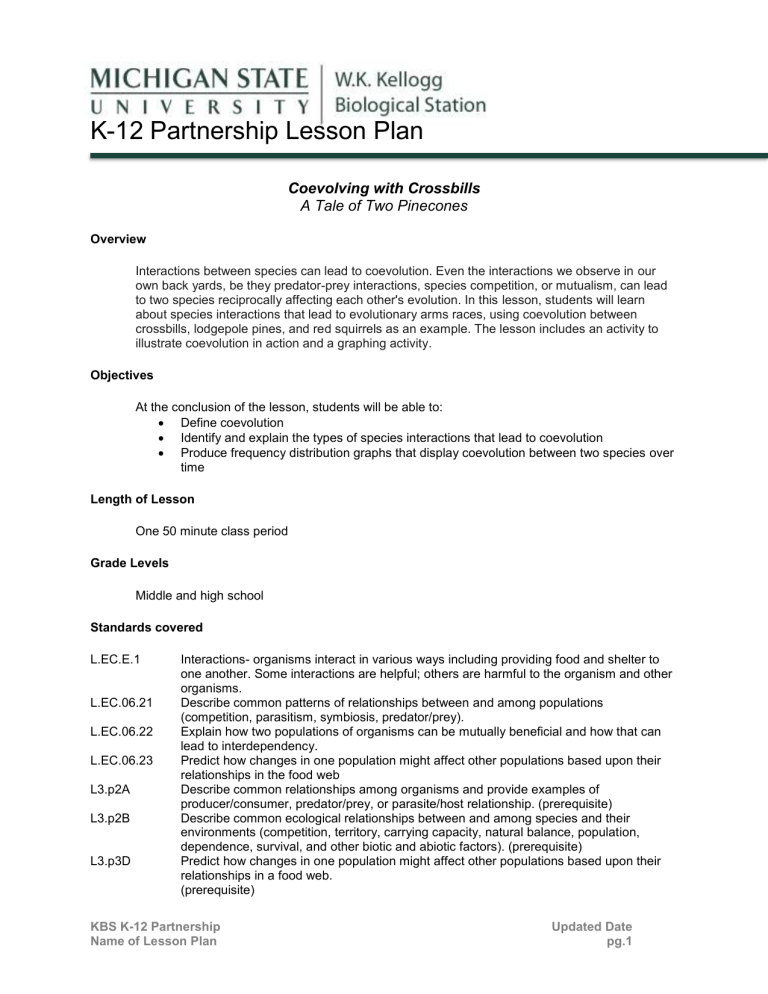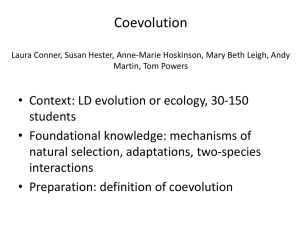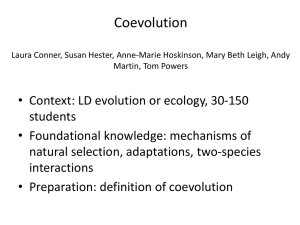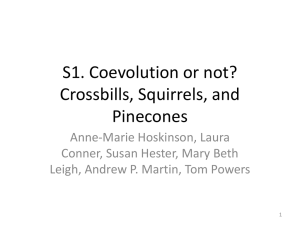coevolution-with-crossbills-lesson-plan

K-12 Partnership Lesson Plan
Coevolving with Crossbills
A Tale of Two Pinecones
Overview
Interactions between species can lead to coevolution. Even the interactions we observe in our own back yards, be they predator-prey interactions, species competition, or mutualism, can lead to two species reciprocally affecting each other's evolution. In this lesson, students will learn about species interactions that lead to evolutionary arms races, using coevolution between crossbills, lodgepole pines, and red squirrels as an example. The lesson includes an activity to illustrate coevolution in action and a graphing activity.
Objectives
At the conclusion of the lesson, students will be able to:
Define coevolution
Identify and explain the types of species interactions that lead to coevolution
Produce frequency distribution graphs that display coevolution between two species over time
Length of Lesson
One 50 minute class period
Grade Levels
Middle and high school
Standards covered
L.EC.E.1
L.EC.06.23
L3.p2A
L3.p2B
L.EC.06.21
L.EC.06.22
L3.p3D
Interactions- organisms interact in various ways including providing food and shelter to one another. Some interactions are helpful; others are harmful to the organism and other organisms.
Describe common patterns of relationships between and among populations
(competition, parasitism, symbiosis, predator/prey).
Explain how two populations of organisms can be mutually beneficial and how that can lead to interdependency.
Predict how changes in one population might affect other populations based upon their relationships in the food web
Describe common relationships among organisms and provide examples of producer/consumer, predator/prey, or parasite/host relationship. (prerequisite)
Describe common ecological relationships between and among species and their environments (competition, territory, carrying capacity, natural balance, population, dependence, survival, and other biotic and abiotic factors). (prerequisite)
Predict how changes in one population might affect other populations based upon their relationships in a food web.
(prerequisite)
KBS K-12 Partnership
Name of Lesson Plan
Updated Date pg.1
Materials
Introductory PowerPoint
Binder clips (4 different sizes: tiny, small, medium, and large, 12 of each)
M&M candies (5 different sizes: mini, regular, peanut butter, peanut, almond, one bag of each)
Paper plates
Paper cups
Data collection spreadsheets
Coevolving with crossbills graphing worksheet
Background
Coevolution occurs when two or more species affect each other’s evolution. For example, an evolutionary change in the morphology of a plant’s flowers can lead to a change in the morphology of the insect that pollinates that plant, which in turn can affect the evolution of the plant, and so forth. Often, species that interact closely with one another can coevolve.
Many types of species interactions, even the ones students can observe in their own backyards, can lead to coevolution. Mutualistic interactions, where two species gain from interacting with each other, can lead to coevolution. Plants and their pollinators can be good examples of mutualists that coevolve. Both species gain from interacting with each other, and also affect each other’s evolution. Predator-prey interactions can also lead to coevolution. A prey species can evolve defenses against its predator, which then evolves to overcome the prey’s defenses, in a sort of evolutionary arms race. For example, a plant can evolve chemical defenses to deter an insect herbivore, which triggers the insect to evolve resistance to those defenses.
This lesson focuses on a classic example of coevolution: that of crossbills, lodgepole pines, and red squirrel in the Rocky Mountains. Crossbills and red squirrels both eat the seeds of lodgepole pine trees by harvesting them from pine cones. In areas where both crossbills and squirrels live, squirrels are the dominant seed predators. Squirrels prefer pinecones that are narrow with many, large seeds. Because of this, trees that grow in squirrel habitats tend to have relatively wide cones with few seeds as a defense against squirrels. In areas without squirrels, crossbills are the dominant seed predator. Crossbills smaller, narrow, thin-scaled cones with many seeds. In response, trees in crossbill-dominated habitats produce longer, wider, thick-scaled cones with fewer seeds as a defense. In response to this, the crossbills have evolved deeper, shorter, less curved bills that are better able to extract seeds from these thick-scaled cones. This example shows how two different selective agents (squirrels and birds) have affected the evolution of lodgepole pines in different ways, and how the crossbills have evolved in response.
In the following activity, students will show coevolution in action by acting as birds harvesting seeds from trees and examining the resulting changes in morphology of bird beaks and seed size.
Activities of the session
1.
Introduction a.
Using the Introductory PowerPoint and background information, explain coevolution, the types of species interactions that can lead to coevolution, and describe the crossbilllodgepole-squirrel example in detail.
2.
Crossbill-seed activity
KBS K-12 Partnership
Name of Lesson Plan
Updated Date pg.2
12
10
8
6
4
2
0 tiny a.
In this activity, students will act as birds that harvest seeds from a tree species (in this case, an M&M tree). Each student will receive a “beak” (a binder clip). During each oneminute round of the activity, each student will attempt to pick up as many “seeds” (M&Ms) as they can using their beak. i.
Before starting, set up “feeding stations.” The activity starts with 200 M&Ms: 40 mini, 40 regular, 40 peanut butter, 40 peanut, and 40 almond. Put roughly equal numbers of each onto 6 different paper plates, and distribute the plates throughout the area where the activity will be played. ii.
Give each student a binder clip beak. Give about half of the students tiny clips, half of the remaining students small clips, half of further remaining student medium clips, and the rest large clips. For example, for 20 students, give 10 tiny clips, 5 small, 3 medium, and 2 large. iii.
Before the first round of seed collection, graph the frequency distribution of both seed size and beak size on the board. Have the student copy the graphs on their graphing worksheets. The graphs should look like this (the beak size distribution will vary by class size): small medium
Beak Size large
50
40
30
20
10
0 mini regular peanut peanut butter
Seed Size almond iv.
Play the first round of the activity. Give the students one minute to pick up as many M&Ms with their beaks as they can. They can only use one hand to manipulate their beaks, and can only pick up one seed at a time. Give each student a paper cup to collect their seeds in. v.
Tally the number and type of seeds collected by each beak size, and enter the data into the given spreadsheet (see spreadsheet instructions for more details). vi.
Redistribute beak and seed sizes proportionally based on the number of seeds collected. Use the spreadsheet to calculate the number of each beak size and the number of each M&M size that will start the next round (the total number of birds and the total number of seeds will always be the same, but the proportion of each size will change from round to round). Redistribute beaks and replenish seeds. The students may eat the seeds they collected. Have the students graph the frequency distributions of the beak and seed sizes that will start the next round. vii.
Repeat steps iv-vi 3 or more times. viii.
Examine the frequency distribution graphs that were produced over the course of the activity. Discuss how the size distributions changed, why the students think they changed, and how this displays coevolution in action.
KBS K-12 Partnership
Name of Lesson Plan
Updated Date pg.3
Resources
Introductory PowerPoint (including links to videos of squirrels and crossbills eating), the graphing worksheet, spreadsheet, and spreadsheet instructions are located online on the gk-12 lessons page.
Red squirrel-crossbill-lodgepole pine system explained in more detail: http://evolution.berkeley.edu/evolibrary/article/evo_34
Extensions and Modifications
This lesson can be tailored to different grade levels by manipulating the level of involvement the students have in calculating the beak and seed size proportions for the crossbill-seed activity. For younger students, the instructor can do the bulk of the calculations and display them on the board. Older students can do the calculations themselves.
Assessment
Students’ graphing worksheets can be can be assessed.
KBS K-12 Partnership
Name of Lesson Plan
Updated Date pg.4








